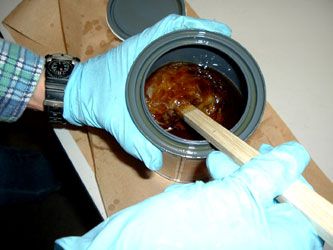


A good way to save money when buying most any type of finish is to buy as small a quantity as possible to do the job. If you run out you can always buy more to complete your project. Buying only what you need not only saves you money, but it also cuts down on the amount of leftover finish you need to store, reuse or dispose of.
If youve ever opened an old can of varnish and found that it has skinned over and the material beneath is very thick or gelled, you know why one should buy only enough product to finish the job at hand.
Oil-based finishes dry and harden by absorbing oxygen. They start to dry as soon as they come into contact with oxygen and continue to do so until the process is complete. No matter how tightly you put the lid back on a container, the drying process will continue utilizing all the air left in the can. The oxygen that's sealed in the container continues to cure and thickens the finish, eventually forming a skin over the top. If the finish is used again, it could result in very slow drying or worst of all, not dry at all.
So, whenever you buy oil finishes such as varnish or penetrating oil, etc., only buy as much as you think you will need to finish the job and transfer whats left over to a smaller container. A product such as
Bloxygen
(195005) can also be used to store your finish safely and will allow you to use ALL your finish, not just the first half. Bloxygen uses a blend of inert gases to drive the oxygen out of your finish container. Since the Bloxygen gases are heavier than air, they sink down and separate the liquid surface from any oxygen that may remain in the container, thus preventing the finish from drying, thickening and skinning over.
If you
do
find yourself with leftover wood finishes, paints, etc., check to see if there is a local recycling or reuse program or household hazardous waste center in your area. The phone number for these resources can frequently be found in the government section of your local telephone directory under Solid Waste, Environmental Protection or Public Works Department. If there is no such program available in your county, city or state, then proper disposal is your last resort. In most states, it is illegal to dispose of finishes in the trash or down storm or sewer drains, because they can contaminate the water supply and ocean waste.
When disposing of finishes, read the label and follow the manufacturer's instructions for proper disposal. Also check with your local recycling or household hazardous waste coordinator or sanitation department regarding acceptable practices in your community for the disposal of dried paints and finishes. To dispose of finishes properly generally you can use the following methods:
Absorb:
Large quantities of latex or acrylic paint, stains and wood finishes - more than two inches in the bottom of a can - may be absorbed with clay-based cat litter. Pour the cat litter into a box or container, then pour the finish into the container and stir. Add cat litter until you can't stir anymore. Put the container with the absorbed paint into your household trash. Recycle open, dry paint cans.
Evaporate:
Small quantities -
less
than two inches in the bottom of a can of water-based or oil-based finishes may be disposed of by allowing the liquid to evaporate. Move the container to a sheltered, outdoor area away from children and pets, remove the lid and allow the finish to dry. Once the liquid evaporates, recycle the open can or discard in the trash.
Recycle Empty Cans:
A container is considered "empty" if no finish can be removed with a brush or by holding it upside down. Leave the lid off the can to allow the remaining residue to dry, then recycle the open can and lid with the metal cans at your towns recycling center. Empty aerosol cans devoid of pigment
and propellant
- may often be disposed of in this manner as well.
And remember, when disposing of oily rags and applicators, always hang them up or spread them out and let them dry thoroughly before discarding.